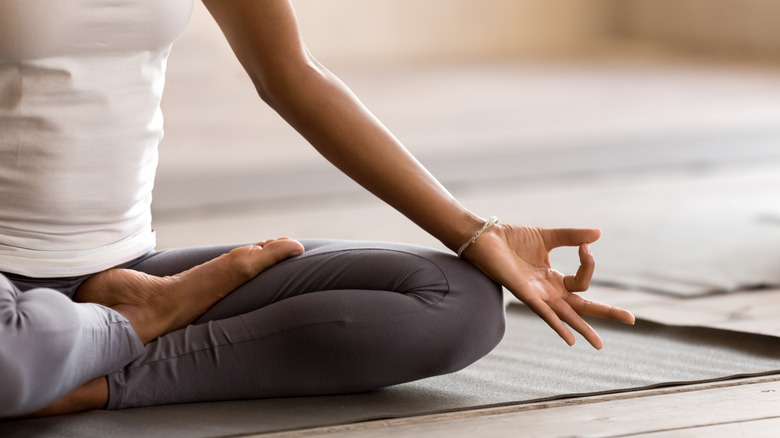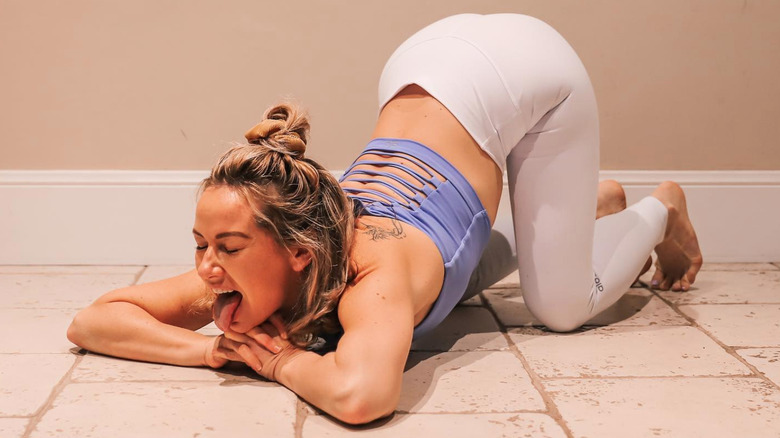Deep-Breathing Techniques For When You Need To Center Yourself
It goes without saying that we are living in some of the most unprecedented anxiety-filled times. It's not easy flipping through the news, seeing new variants of new viruses, and increased pressure to maintain work through years of a pandemic. However, we don't want to harp on this too long and add to any already present anxieties. Instead, let's redirect our attention to calling back our power, centering ourselves, and tapping into personal strength.
One of the easiest ways to do this is to reconnect with your breath — something we may not do enough of in our fast-paced society. According to doctors at the University of New Mexico, breathing techniques can help with relaxation, stress management, and the regulation of psycho-physiological states. A 2018 study also found that different breathing patterns activate parts of the brain that control mood, attention, awareness, and other otherwise automatic neural processes. By focusing attention on our breath, we can get back in the control seat, an underrated technique that has proven to regulate stress and anxiety. Try these five different techniques to recenter and heal your nervous system.
Breathe through your belly
You know that feeling when you get nervous, hold your breath, then your belly tenses up? It turns out the stomach is a tremendous well for both stress and relaxation. It can either hold onto emotion or release it. According to Cleveland Clinic, the diaphragm, or the sizeable dome-shaped muscle at the base of your stomach, is the best area to work on breathing. Focus on this area by placing one hand on your belly and the other on your chest. Allow yourself to let go of all tenseness in the body to let the area relax. Women, especially those of us who have been taught to suck in our entire lives, rarely let this area relax to its fullest. As you breathe slowly into your nose, allow your diaphragm to expand to its fullest potential with no judgment. Practice this breathwork for up to ten minutes daily to work through anxiety, stress, asthma, or COPD.
Breathe like the yogis
If you've practiced yoga, you may remember hearing your instructor telling you to take an ujjayi breath. This ancient technique means "victorious breath" and is intended to emulate the sound of an ocean by letting out a shameless and audible exhale (via Chopra). To practice, start with your mouth closed and take a deep inhale through the nostrils. As you muster some courage, exhale out through the mouth with a soft yet powerful, "HAHHHHHH." Repeat and notice how you feel tense energy leaving your body through exhales. Something about hearing your own breath sound like crashing waves is enough to recenter and ground in your power.
Breathe like a lion
If breathing like an ocean felt cathartic, try breathing like a lion. Lion's breath was developed as a meditational breathing technique in ancient India and is used to release stress and tension in both the body and mind (via Norton Simon Museum). If you're willing to get past the silliness, it can be quite therapeutic and even empowering. To start, kneel on the floor. Next, look up at the ceiling or straight ahead and take a big inhale through the nose. Then with your tongue out towards your chin, let out an audible "HAHHH" like you would with the ujjayi breath. This ancient breathing technique, also called Simha pranayama, has been proven to calm anxieties and energize one's body (VeryWellFit).
Make your breath a box
When we say make your breath a box, we mean visually. Whether or not it's the breathing pattern or visual picture painting that makes this technique so relaxing is debatable. Start by envisioning drawing a box starting at the top left corner. As you inhale for a count of four, draw a line to the top right corner. Now hold for a count of four as you go down to the bottom right. As you exhale, draw the line to the bottom left, and hold your breath for a count of four as you draw the line back to the top where you started. A 2017 study found that when participants used breathing techniques like the box breath, levels of the stress hormone cortisol dropped significantly.
The 4-7-8 Method
The 4-7-8 breathing method is a classic stress response to have in your emotional balancing arsenal. If you find yourself battling anxiety or tense situations during the day, return to this method. Experts at WebMD recommend starting with your tongue placed in front of your teeth while seated comfortably. Exhale through the mouth to make a "whoosh" sound, then take the first inhale for a count of four through the nose. Next, hold your breath for a count of seven. Finish by letting out a relaxing exhale for a count of eight. Repeat for three or more cycles or until you feel calmer and more centered. This elongated breathing process is best for winding down at night and releasing anger, anxiety, and tension.





